#repair biodiversity
Explore tagged Tumblr posts
Text
https://lnkd.in/e7fJkt-Y
https://lnkd.in/e96rw6tr EVERYBODY ACT NOW! XR HUMANITY’S EMERGENCY SERVICES SOCIAL, CLIMATE JUSTICE LOCAL, STOP THE ROT - FREE RESOURCES UPDATED 31 July 2023
#xr#extinction rebellion#act now xr humanity's emergency services social climate justice local#end fossil fuels#end all fossil fuels#remove methane hydro dams#free rivers#repair natures arteries#repair biodiversity#restore nature#dam removal#fund nature#protect nature
0 notes
Text
In the tradition.
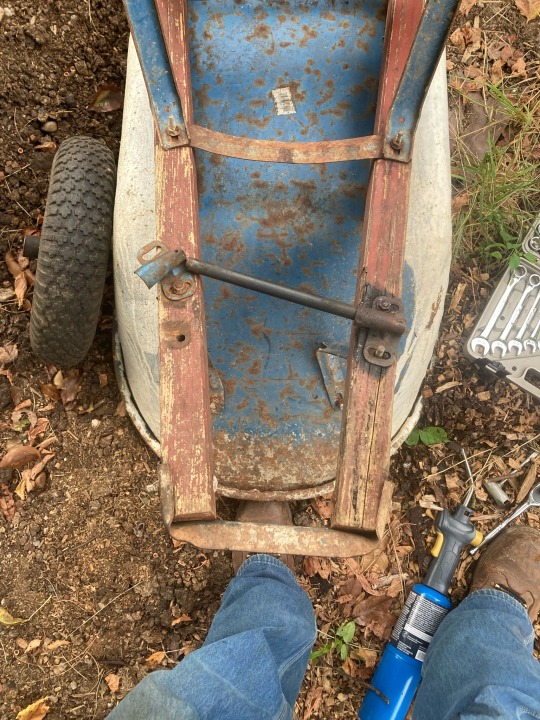
When you operate a small farm, stuff happens and ya gotta stop and repair, replace or recycle what’s broken. It’s not always easy and it definitely is a time commitment, however, it still remains a blessing because during the downtime, lessons are learned.
What have you fixed recently?
#visionarygrowingsolutions#atlanta airbnd experience#simple food small farmz air bnb agriculture experience#small farmz simple food#small farms#farm repair#farm tools#soil food web#compost#atlanta urban ag#biodynamic#soil#biodiversity#soil creation#permaculture#urban ag#food systems#maurice small
26 notes
·
View notes
Text
November 2, 2024
October came and went like a lightening bolt, my apologies it's been a bit since I posted, things have gotten a bit crazy this way with some personal things. With luck now the October shuffles just about done and the November tubslide will be a bit gentler.
Onto some urban homesteading and otherwise~
I'm going to have to restart my fall seeds. Unfortunately, there was a bit of a situation which killed off my seed table and started plants entirely. For the most part, it's sorted, but I'll have to begin my fall and winter crops from scratch and hope there's time for em to grow. Otherwise I'll need to figure some other crops instead. Probably more chicken food or flowers/peas instead.
Thankfully, the already established in ground crops were okay for the most part. Some a bit stressed or stunted from lack of consistent watering.

Sweet potato has already started flowering now, i really didn't get any greenery from it so far (mayby a pound), so I'm just gonna let it keep going for now. When it msotly dies back I'll dig them out.
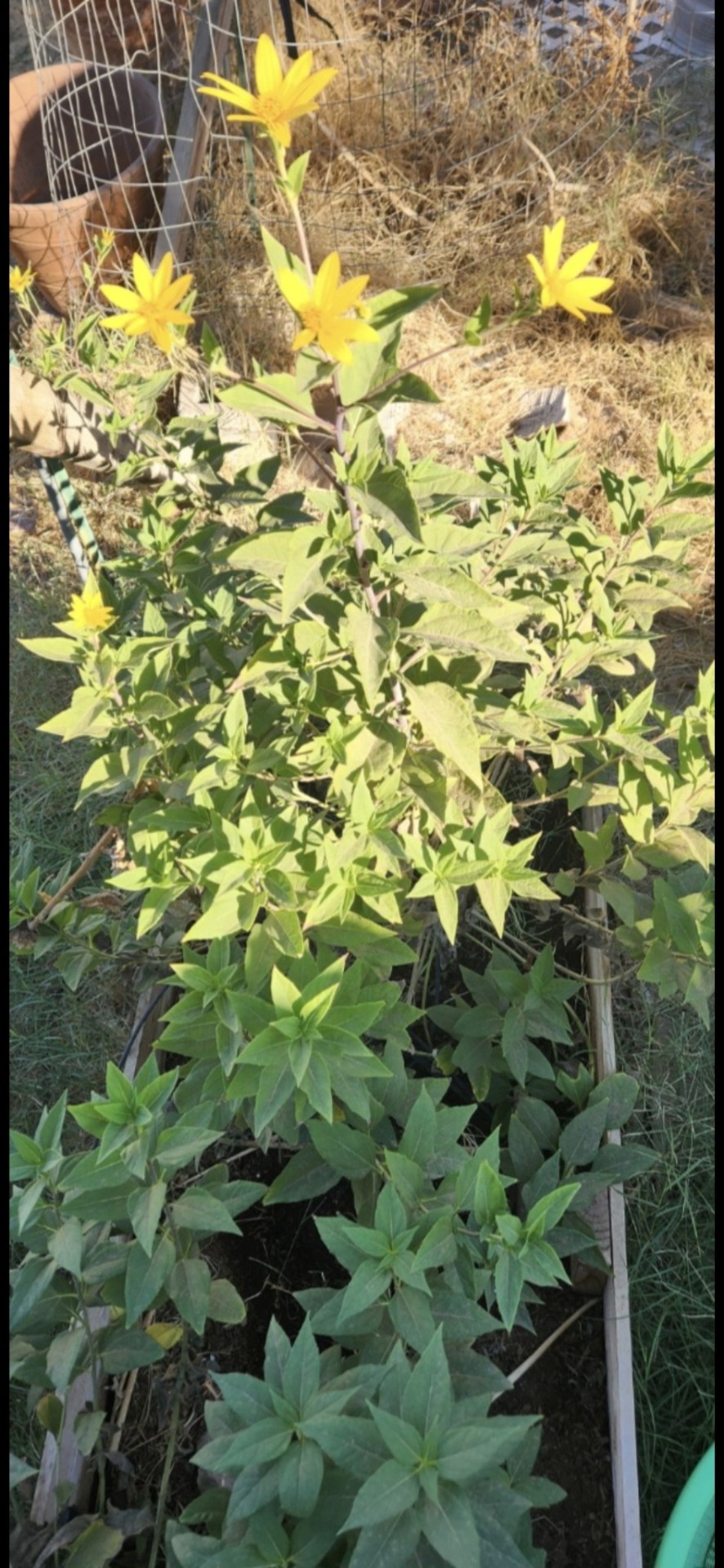
The sunchoke has now begun flowering, it's rather different than the last flowering I thought it did. Mayby a regular sunflower got mixed in? I did plant them around the time the regular sunflowers started sprouting.
I'm pretty excited to try the Tubers out, if there's enough for a decent harvest. Otherwise I'm taking them and spreading to another bit of the garden for fill in and propogation.

I can confirm, we do have a rooster. His name is Heihei. He's not gone through full second molt, but we've seen his curly feather, now hear his crowing and have caught him doing what roosters do lol.
Looks like I may get to try out hatching after all :)
No new layers so far, but hoping soon :)

Spotted this feather, which i believe belongs to one of the local woodpeckers. (I didn't take it, not allowed where I live)
Also have started spotting hummingbirds more locally and regularly. The parrots have returned again, though they aren't currently visiting us (no sunflowers yet ) and I think we've had a few female cardinals visit the lambs quarter plant I'm letting go to seed. Haven't noticed much in new bug species.

I got to learn how to change tires on a dolly this month. It was quite a bit easier than expected, cost less than $30 and gave new life to a good tool.
Thats it for now, ive got some chores to do and hopefully some time to get garden set up a bit :) new photos and updates coming ASAP!
🌱🍊Happy Urban homesteading🍊🌱
#homesteading#thestudentfarmer#self sufficient living#studentfarmer#self sufficiency#food#garden#gardening#low waste#chickens#rooster#urban biodiversity#urban green spaces#urban homesteading#urban gardening#urban farming#reduce reuse recycle#fixing things#repair#seed starting#restart#sunchoke#sweet potatoes#crop failure
6 notes
·
View notes
Text
So this is a really creative solution to a pernicious ecological problem! The short version is that arid ecosystems like deserts are quite fragile. For example, many have soil that is covered in a thin biocrust that can be damaged just by walking or driving on it. And because life needs water to grow and recover, these super-dry ecosystems may not be able to repair a footprint or tire track for over a century.
However, arid ecosystems are often some of the least understood because they can be difficult to access. And they suffer from P.R. issues because deserts are often seen as "bad" ecosystems full of death and nothingness, and because we do legitimately want to avoid the desertification of other native habitats.
In order to raise awareness and appreciation of these landscapes, biological surveys that tally the living beings found there help show how biodiverse they can be. And when we know more about how abundant or scarce a given species there is, it gives us more impetus to protect them, especially those that are at risk of extinction.
These paramotorists were able to fly across Peru's lomas (coastal fog deserts), which primarily receive scant amounts of moisture from mist. They collected plant samples to take back to scientists, carefully recording where they were found. And because they were able to fly long distances, they could minimize the amount of time their feet were on the ground and therefore minimize their impact on the local ecology.
At a time where it seems every interaction between motorized technology and nature is a negative one, this is a pleasant departure. yes, of course we wish we weren't in a place where we have to be worried about increasing extinction and other ecological woes. But let's take the wins where we can; the morale boost is crucial to being able to keep looking toward a better future.
#desert#lomas#ecology#botany#plants#native plants#science#scicomm#nature#endangered species#extinction#environment#conservation#biology#hopepunk#good news#paramotor#paragliding
1K notes
·
View notes
Text
"High along the peaks and ridges of the mountains in Ecuador, a 25-year-long conservation program is bearing succulent fruit in the form of cleaner water and abundant wildlife.
Established in the year 2000, Quito’s fund for the protection of water has allowed a critical South American ecosystem unique to the world and vital to both plants and animals to reclaim vast tracts of its former landscape, and people are noticing the difference.
“Before the water fund, the páramo in Antisana was very degraded. The only thing you would see was sheep.” Silvia Benitez, the Nature Conservancy’s Director of Freshwater for Latin America, said in a statement. “The change has been amazing. Vegetation is back. The wetlands are restored.”
“Now people see groups of deer. They see puma. I saw a fox. I had never before seen a fox in this area.”
The story of this quarter-century success began when the United States nonprofit the Nature Conservancy partnered with Quito’s water utility company, known as EPMAPS. The second-highest capital city on Earth by altitude, Quito is surrounded by a famous ecosystem called the páramo, a biodiversity hotspot where masses of mosses, lichen, high-altitude palms, and endemic grasses create a mountain environment unlike any other.
The páramo covers slopes above 10,000 feet in elevation all over the Andes Mountains, and acts like a giant sponge absorbing and condensing moisture from the lower ground before releasing it in streams and rivers further down. The Nature Conservancy estimates that in Colombia, where páramos cover just 2% of land area, this hydrological service provides 70% of all municipal water. It’s estimated that páramo sequesters 6 times more carbon than tropical rainforest.
EPMAPS and the Nature Conservancy organized $21,000 in seed money to kick-start a trust fund that would charge downstream users of water from the páramos around Quito for the conservation measures needed to protect them.
Called the Fund for the Protection of Water, or FONAG, it’s accumulated $2.5 million in annual contributions over the last 25 years, and as a result, páramos are retaking ranchland that once displaced them, and the wildlife like whitetail deer, Andean bears, Mountain tapirs, and condors are returning as well.
“Since FONAG’s beginning, its priority has always been the protection of the water sources. But when you conserve water sources, it’s almost automatic that you have other co-benefits—biodiversity, carbon sequestration, and social benefits,” said Bert de Bievre, Technical Secretary of FONAG.
Local communities have become very involved in FONAG’s work. Two dozen have become páramo rangers, local ranchers have moved their animals to lower elevations, agriculturalists have worked with EPMAPS to switch to low-impact methods of cultivation away from watersheds, and the Nature Conservancy runs a nursery that grows many of the endemic páramo plants for use in reforestation.
The Quito-FONAG model is now being implemented across the northwestern areas of South America, and it shows how much can be achieved by simply letting rivers run free.
“Each year, the global water sector spends $700 billion on building and repairing pipes and reservoirs, using grey solutions to engineer themselves out of a problem created by deforestation, agriculture or other threats upstream,” said Brooke Atwell, Associate Director of the Nature Conservancy’s Resilient Watersheds strategy.
“If we were able to reallocate just 1% of that spending ($7 billion) toward protecting nature, it would eclipse all global philanthropic spending on conservation today.”"
-via Good News Network, April 1, 2025
#ecuador#south america#quito#quitoecuador#rivers#ecosystem#ecosystem restoration#water#biodiversity#endangered species#water conservation#good news#hope
654 notes
·
View notes
Text
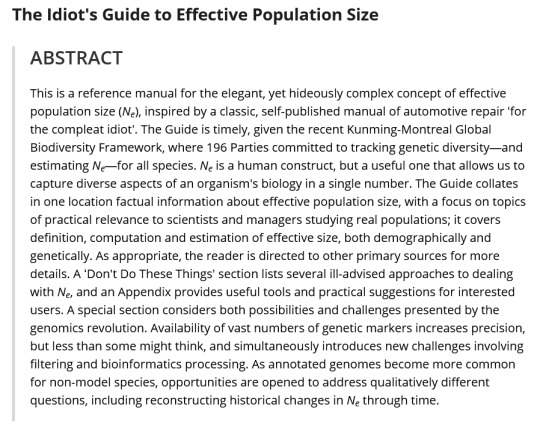
[The Idiot's Guide to Effective Population Size
This is a reference manual for the elegant, yet hideously complex concept of effective population size (Ne), inspired by a classic, self-published manual of automotive repair ‘for the compleat idiot’. The Guide is timely, given the recent Kunming-Montreal Global Biodiversity Framework, where 196 Parties committed to tracking genetic diversity—and estimating Ne—for all species. Ne is a human construct, but a useful one that allows us to capture diverse aspects of an organism's biology in a single number. The Guide collates in one location factual information about effective population size, with a focus on topics of practical relevance to scientists and managers studying real populations; it covers definition, computation and estimation of effective size, both demographically and genetically. As appropriate, the reader is directed to other primary sources for more details. A ‘Don't Do These Things’ section lists several ill-advised approaches to dealing with Ne, and an Appendix provides useful tools and practical suggestions for interested users. A special section considers both possibilities and challenges presented by the genomics revolution. Availability of vast numbers of genetic markers increases precision, but less than some might think, and simultaneously introduces new challenges involving filtering and bioinformatics processing. As annotated genomes become more common for non-model species, opportunities are opened to address qualitatively different questions, including reconstructing historical changes in Ne through time.]
Waples (2025)
235 notes
·
View notes
Text
Inside William’s Next Act: Tatler’s May issue goes behind the scenes as the Prince of Wales is rising above the noise — and playing the long game
The burden of leadership is falling upon Prince William, but as former BBC Royal Correspondent, Wesley Kerr OBE, explains in Tatler’s May cover story, the future king is taking charge
By Wesley Kerr OBE
21 March 2024
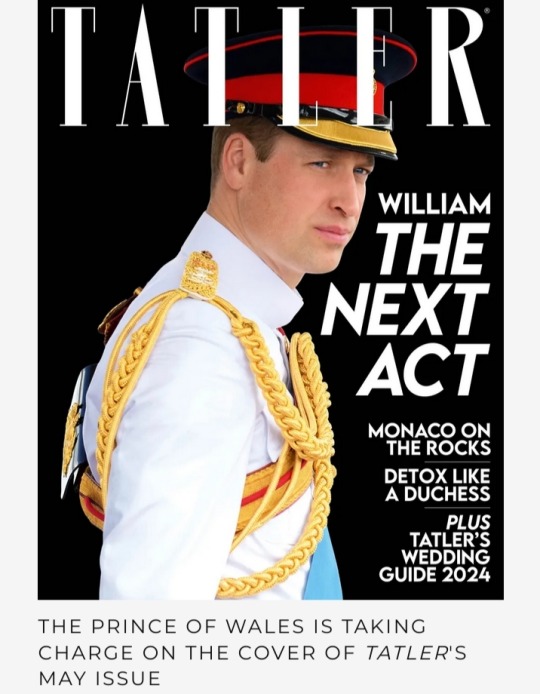
When I first met Prince William in 2009, he asked me if I could tell him how he could win the National Lottery.
It was a jokey quip from someone who has since become the Prince of Wales, the holder of three dukedoms, three earldoms, two baronies and two knighthoods, and heir to the most prestigious throne on earth.
He was, of course, being relatable; I was representing the organisation that had allocated Lottery funding towards the Whitechapel Gallery and he wanted to put me at ease.
William is grand but different, royal but real.
At 6ft 3in, he has the bearing and looks great in uniform after a distinguished, gallant military career.
He will be one of the tallest of Britain’s kings since Edward Longshanks in the 14th century and should one day be crowned sitting above the Stone of Scone that Edward ‘borrowed.’
William, by contrast, has a deep affinity with Scotland and Wales, having lived in both nations and gained solace from the Scottish landscape after his mother died.
He’s popular in America and understands that the Crown’s relationship to the Commonwealth must evolve.
The Prince of Wales has long believed that ‘the Royal Family has to modernise and develop as it goes along, and it has to stay relevant’, as he once said in an interview.
He seeks his own way of being relatable, of benefitting everybody, in the context of an ancient institution undergoing significant challenge and upheaval, as the head of a nation divided by hard times, conflicts abroad, and social and political uncertainty.
We might recognise Shakespeare’s powerful line spoken by Claudius in Hamlet: ‘When sorrows come, they come not single spies, but in battalions.’
With the triple announcement in January and February of the Princess of Wales’s abdominal surgery and long convalescence, of King Charles’s prostate procedure and then of his cancer diagnosis, the burden of leadership has fallen on 76-year-old Queen Camilla and, crucially, on William.
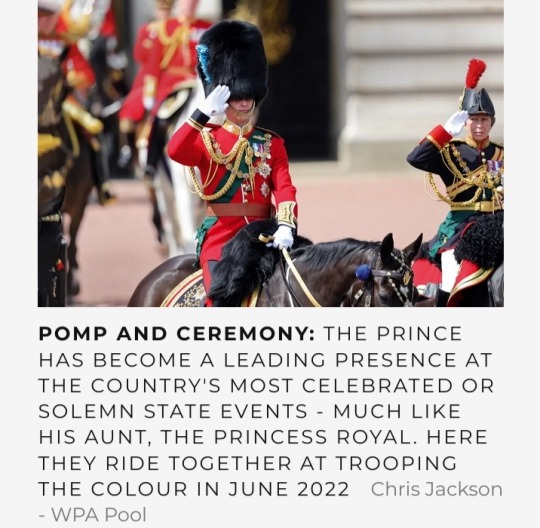
The Prince of Wales’s time has come to step up; and so he has deftly done.
In recent months, we have seen a fully-fledged deputy head of state putting into practice his long-held ideas, speaking out on the most contentious issue of the day and taking direct action on homelessness.
Last June, he unveiled the multi-agency Homewards initiative with the huge aspiration of ending homelessness, backed with £3 million from his Foundation to spearhead action across the UK.
He is consolidating Heads Together, the long-standing campaign on mental health, and fundraises for charities like London’s Air Ambulance Charity.
He was, of course, once a pilot for the East Anglian Air Ambulance services – a profession that had its downside: seeing people in extremis or at death’s door, he found himself ‘taking home people’s trauma, people’s sadness.’
Tom Cruise was a guest at the recent London’s Air Ambulance Charity fundraiser, William’s first gala event after Kate’s operation.
And more stardust followed when William showed that, even without his wife by his side, he could outclass any movie star at the Baftas.
There’s also his immense aim of helping to ‘repair the planet’ itself with his Earthshot Prize: five annual awards of £1 million for transformative environmental projects with worldwide application.
This project has a laser focus on biodiversity, better air quality, cleaner seas, reducing waste and combating climate change. Similar aims to his father; different means to achieve the goal.

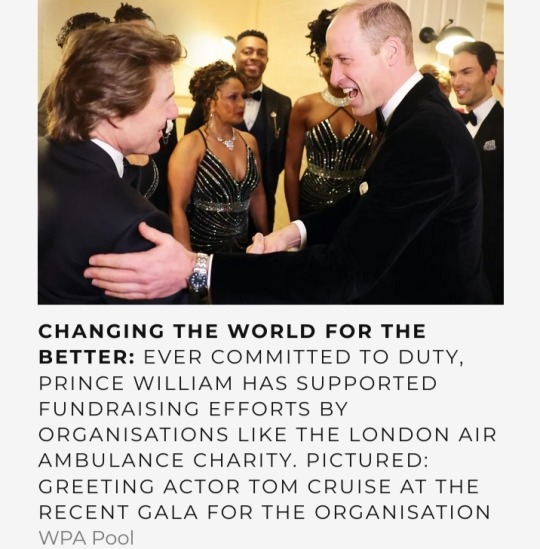
On the issue which has caused huge convulsions – the Middle East conflict – William’s 20 February statement from Kensington Palace grabbed attention.
He said he was ‘deeply concerned about the terrible human cost of the conflict since the Hamas terrorist attack on 7 October. Too many have been killed.’
There were criticisms – along the lines of ‘the late Queen would have never spoken out like this’ or ‘what right does he have to meddle in politics?’ – but it was hard to disagree with his carefully calibrated words.
His call for peace, the ‘desperate need’ for humanitarian aid, the return of the hostages.
The statement was approved by His Majesty’s Government, likely cleared with the King himself at Sandringham the previous weekend and also backed by the chief rabbi of Great Britain, Sir Ephraim Mirvis.
Indeed, William and Catherine had immediately spoken out on the horrors of 7 October.
William followed up the week after his Kensington Palace statement by visiting a synagogue and sending a ‘powerful message’, according to the chief rabbi, by meeting a Holocaust survivor and condemning anti-Semitism.
This is rooted in deep personal conviction following William’s 2018 visit to Israel and the West Bank, says Valentine Low, the distinguished author of Courtiers and The Times’s royal correspondent of 15 years, who was on that 2018 trip.
‘William was so moved by his visit to Israel and the West Bank, he found it very affecting, and he was not going to drop this issue – he was going to pay attention to it for the rest of his life,’ says Low.
‘He must feel that… not to say something on the most important issue in the world [at that moment] would be a bit odd if you feel so strongly about it.’
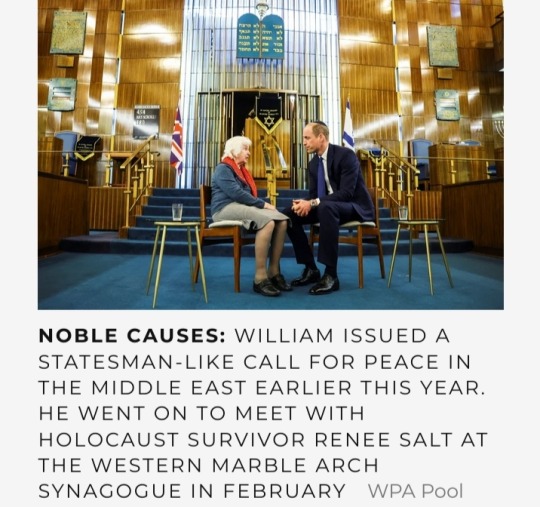
There was concern from some commentators about politicising the monarchy, but this rose above the particulars of party politics.
As Prince of Wales, like his father before him, there is perhaps space to speak out sparingly on carefully chosen issues.
On this occasion, his views were in line with majority public opinion.
On homelessness, news came that same week that William was planning to build 24 homes for the homeless on his Duchy of Cornwall estate.
‘William’s impact is very personal,’ says Mick Clarke, chief executive of The Passage, a charity providing emergency accommodation for London’s homeless.
‘Two weeks before Christmas, the prince came to our Resource Centre in Victoria for a Christmas lunch for 150 people.
He was scheduled to stay for an hour, to help serve, wash up, and talk to people.
He ended up staying for two and a quarter hours, during which time he went from table to table and spoke to every single person.’
Clarke continues:
‘William has an ability to listen, talk and to put people at ease. During the November 2020 lockdown, he came on three separate occasions to help.
It gave the team a boost that he took the time; it was his way of saying: “I support you; you’re doing a great job.”’
Seyi Obakin, chief executive of Centrepoint, one of the prince’s best-known causes, adds:
‘People associate his patronage with the big moments like the time he and I slept under Blackfriars Bridge.
The things that stick with me are smaller in scale and the more profound for it – in quieter moments, away from the cameras, where he has volunteered his time.’
It is a different approach from the King’s.
As Prince of Wales, he was involved in the minutiae of dozens of issues at any one time, working into the night to follow up on emails, crafting his speeches, writing or dictating notes.
Add to that much nationwide touring over 40 years (after he left active military service in 1976), fitting in multiple engagements, often being greeted formally by lord lieutenants.
This is not William’s style. He has commended his father’s model, but he does things his own way.
Although patronages are under review, William has up till now far fewer than either his father or his grandparents.

Charles is sympathetic to William’s approach and his desire to make time with his young family sacrosanct.
They are confidantes, attested by the night of Queen Elizabeth’s death.
They were both at Birkhall with Camilla, reviewing funeral arrangements while the rest of the grieving family were nearby at Balmoral, hosted by the Princess Royal.
Charles has had almost six decades in public life and is the senior statesman of our time, with even longer in the spotlight than Joe Biden.
After Eton and St Andrew’s University, where he met Catherine, William served in three branches of the military between 2006 and 2013, finishing as a seasoned and skilled helicopter rescue pilot.
His later employment as an air ambulance pilot stopped in 2017, when he became a full-time working royal.
At that time, not so long ago – with Harry unmarried, Andrew undisgraced, and Philip and Elizabeth still active – William shared the spotlight.
Now, after the King, he’s the key man.
He can look back on the success of his first big campaign initially launched with his wife and brother in 2016: Heads Together.
‘We are delighted that Prince William should have become such a positive and sympathetic advocate for mental health through his Heads Together initiative and now well-established text service, Shout, among other projects,’ says the longtime CEO and founder of Sane, the remarkable Marjorie Wallace CBE.
‘It is not always known that he follows in the footsteps of his father, the King, whose inspiration and vision were vital in the creation of our mental health charity Sane.
As founding patron, he was instrumental in establishing our 365-days-a-year helpline and was a remarkable and selfless support to me in setting up the Prince of Wales International Centre for Sane Research.’
'Indeed,' says Wallace, 'this is where Prince William echoes the work of his father, showing the same ‘understanding and compassion for people struggling through dark and difficult times of their lives and has done much to raise awareness and encourage those affected to speak out and seek help.
We owe a huge debt to His Majesty and the Prince of Wales for their involvement in this still-neglected area.’
Just as I saw all those years ago at that early solo engagement in Whitechapel, William still approaches his public duties with humour and fun.
‘He defuses the formality with jocularity,’ says Valentine Low, citing two public events in 2023 that he witnessed.
In April last year, while on a visit to Birmingham, William randomly answered the phone in an Indian restaurant he was being shown around and took a table booking from a customer – an endearing act of spontaneity.
On his arrival later that day, the unsuspecting diner was surprised to be told exactly whom he had been talking to.
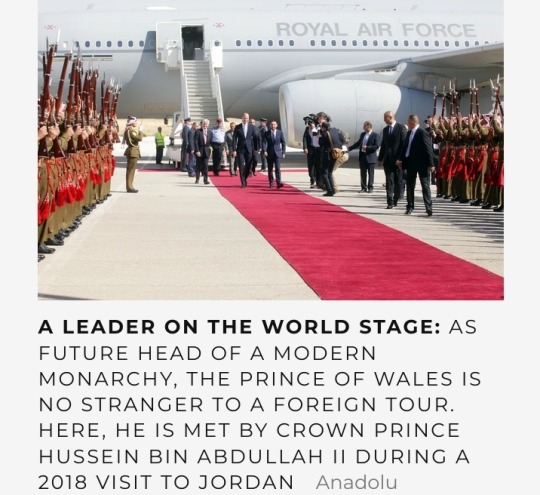
In October, Low reported, William ‘unleashed his inner flirt as he hugged his way through a visit with Caribbean elders [in Cardiff] to mark Black History Month.
As he gave one woman a hug – for longer than she expected – he joked: “I draw the line at kissing.”
And while posing for a group photograph, he prompted gales of laughter when he quipped: “Who is pinching my bottom?”’
Low believes that when William eventually becomes king, he will be more ‘radical’ than his father but wonders if people will respond to ‘call me William’ when ‘the whole point of the Royal Family is mystique and being different.’
However, William has thought deeply about his current role and is prepared for whatever his future holds.
For now, there is a decision to be made on Prince George’s secondary schooling. It’s said that five public schools are being considered, all fee-paying.
Eton is single-sex and boarding but close to home. Marlborough (Catherine’s alma mater) is co-ed and full boarding. And Oundle, St Edward’s Oxford and Bradfield College (close to Kate’s parents) are co-ed with a mix of boarding and day.
As parents, William and Catherine aspire to raise their children ‘as good people with the idea of service and duty to others as very important’, William said in an interview with the BBC in 2016.
‘Within our family unit, we are a normal family.’ Which may be one reason why he is so resistant to their privacy being compromised either by the media or close family members.

The 19th-century author Walter Bagehot wrote:
‘A family on the throne is an interesting idea also. It brings down the pride of sovereignty to the level of petty life… a princely marriage is the brilliant edition of a universal fact, and, as such, it rivets mankind.’
If hereditary monarchy is to survive, it must beguile us but also demonstrate its utility, that it is a force for good.
William said in that 2016 interview, ‘I’m going to get plenty of criticism over my lifetime,’ echoing Queen Elizabeth II’s famous Guildhall speech in 1992 ‘that criticism is good for people and institutions that are part of public life. No institution – city, monarchy, whatever – should expect to be free from the scrutiny of those who give it their loyalty and support, not to mention those who don’t.’
William saw close up his mother’s ability to bring public focus and her own personal magnetism to any subject or cause she focused on.
He admires his father’s work ethic, the way he ‘really digs down,’ sometimes literally (I understand that gardening is giving the King solace during his cancer treatment).
But the biggest influence for William was Her late Majesty, as he said on her 90th birthday.
As an Eton schoolboy, William made weekend visits to the big house on the hill, being mentored by Granny rather as she had been tutored in the Second World War by the then vice-provost of Eton, Sir Henry Marten.
William said in 2016:
‘In the Queen, I have an extraordinary example of somebody who’s done an enormous amount of good and she’s probably the best role model I could have.’
That said, his aim was ‘finding your own path but with very good examples and guidance around you to support you.'
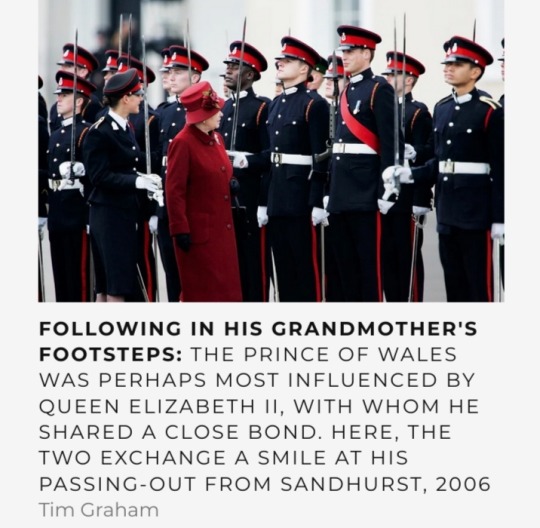
Queen Elizabeth II had a brilliant way of rising above the fray and usually being either a step ahead of public opinion or in tune with it.
If you are at the helm of affairs in a privileged hereditary position, your duty is to serve and use your pulpit for the benefit of others.
In a democracy, monarchy is accountable.
The scrutiny is intense, with an army of commentators paid for wisdom and hot air about each no-show, parsing each announcement, interpreting each image.
William takes the long view. He has ‘wide horizons,’ says Mick Clarke.
‘There are so many causes that are more palatable and easier to achieve than ending homelessness, but his commitment and drive are 100 per cent.’
The prince seeks a different way of being royal in an ancient institution that must move with the times. His task? To develop something modern in an ever-changing world.
He faces all sorts of new issues – or old issues in new guises.
Noises off from within the family don’t help – Andrew’s difficulties, or the suggestions of prejudice from Montecito a couple of years ago (now seemingly withdrawn), which prompted William’s most vehement soundbite: ‘We’re very much not a racist family.’
William is maybe a new kind of leader who can keep the monarchy relevant and resonant in the coming decades.
Queen Elizabeth II is a powerful exemplar and memory, but she was of her time. William is his own man.
He must overcome and think beyond ‘the unforgiving minute.’
Indeed, he could seek inspiration in Rudyard Kipling’s poem, If.
If you can force your heart and nerve and sinew
To serve your turn long after they are gone,
And so hold on when there is nothing in you
Except the Will which says to them: ‘Hold on!’
If you can talk with crowds and keep your virtue,
Or walk with Kings—nor lose the common touch[…]
Yours is the Earth and everything that’s in it,
And—which is more—you’ll be a Man, my son!

This article was first published in the May 2024 issue, on sale Thursday, 28 March.
#Prince William#Prince of Wales#British Royal Family#Wesley Kerr OBE#Edward Longshanks#Homewards#Heads Together#London’s Air Ambulance Charity#East Anglian Air Ambulance#Tom Cruise#BAFTAS#Earthshot Prize#Kensington Palace#King Charles III#Sir Ephraim Mirvis#Valentine Low#Duchy of Cornwall estate#The Passage#Centrepoint#Birkhall#Sane#Marjorie Wallace CBE#Shout#Balmoral#Prince George#Walter Bagehot#Sir Henry Marten#Rudyard Kipling#If
150 notes
·
View notes
Text
How to Repair the Planet? One Answer Might Be Hiding in Plain Sight. (New York Times)
Yes, yes and another triple yes to this premise of this article: we can address the various global crises facing us by looking at them "holistically" rather than as separate silos. I've been harping on this since I started this blog: deal with the "traditional" environmental issues, such as the collapse of biodiversity, properly, and simultaneously we might also be dealing with the newer and evolving climate crisis issues. All part of one, instead of separate kingdoms that benefit academia rather than the rest of us.
Excerpt from this New York Times story:
Sometimes, human needs can make problems like climate change and biodiversity collapse seem insurmountable. The world still relies on fossil fuels that are dangerously heating the planet. People need to eat, but agriculture is a top driver of biodiversity loss.
But what if we’re looking at those problems the wrong way? What if we tackled them as a whole, instead of individually?
A landmark assessment, commissioned by 147 countries and made public on Tuesday, offers the most comprehensive answer to date, examining the sometimes dizzying interconnections among biodiversity, climate change, food, water and health.
“Our current approaches to dealing with these crises have tended to be fragmented or siloed,” said Paula Harrison, a co-chair of the assessment and an environmental scientist who focuses on land and water modeling at the UK Center for Ecology & Hydrology, a research organization. “That’s led to inefficiencies and has often been counterproductive.”
The report, by the Intergovernmental Science-Policy Platform on Biodiversity and Ecosystem Services, an independent panel that advises governments on biodiversity issues, focuses heavily on solutions. It includes scores of potential interventions along with their cascading effects. For example, the authors note that efforts like incorporating prairie strips, areas of native vegetation amid crop rows, or strategically locating trees on farmland can help with biodiversity, food production, human well-being, water quality and climate change all at once.
Not all situations will have multiple wins. Often, negative consequences are unavoidable. But people should be aware of the trade-offs and make them deliberately, from national governments all the way to local communities, the authors said.
“Right now, we don’t take account of a lot of the trade-offs,” said Pamela McElwee, also a co-chair of the assessment and a professor of human ecology at Rutgers University. “And so, they get passed on to somebody else.”
Overlooked costs to biodiversity, climate, water and health from the fossil fuel, agriculture and fisheries sectors were estimated at $10 trillion to $25 trillion per year. Negative health consequences were especially costly, Dr. McElwee said. For instance, she pointed to the nine million people a year who die from air pollution, and the rise in obesity and diabetes because of unhealthy diets that also harm biodiversity and contribute to climate change.
14 notes
·
View notes
Note
Can you tell me about sustainable architecture based on indigenous knowledge. I am an anthropology major and this reminds me of decolonization and what it can do for everyone.
Hello! Heck yes! Theres a lot of Indigenous communities that did this, but an example that keeps coming up is what the Seminoles did in Florida. They built Chickees, which are smaller cabins on stilts driven very deeply into the mud and clay of wetlands. The logs they used were mostly cypress, whoch has antibacterial and waterproof properties.
One of the coolest aspect of chickees is that the Seminoles werent focused on just what was above the ground, but directly under the chickee. People tend to forget that most wetlands are actually really biodiverse in regards to botany, and grasses and sedges are both important for stability. So when the Seminoles were building, they were looking for wet areas that already had a lot of grasses growing in and around the water, and if they wanted the chickee to stand for longer (more than a few months), theyd strategically seed in grasses right under the chickee to reinforce the stilts over the course of the year.
So okay, now that brings us to today, and to modern building. We know that just throwing a slab of concrete down in the middle.of a wetland isnt gonna last, but we do it anyways and spend a LOT of time and resources repairing foundations, pumping out flooded basements, etc. But we do know how to build suspended floor buildings- exactly as it sounds, buildings on cement stilts driven deep into the ground. They look all slick and swoopy and futuristic, but its literally the same structure as chickees- foundation poles driven so deep that flowing water wont easily knock it over or rot it out.
And its not just that the building isnt impedeing the water flow- there needs to be botanic biodiversity as well. So yeah, we cant easily plant seeds under the suspended building, but we can heavily seed in those native grasses along the banks. Native plants are used to disturbances anyways and are evolved to not only roll with the punches, but also thrive on them. So now we get a building that people can use, not disturbing the water, and a bunch of native plants both supporting biodiversity and strengthening the waterway's shores.
TL/DR: When white folks came here from drier, flatter parts of the world, they ignored the basics that Indigenous people knew and did what worked back home. It created a hot mess, and instead of listening the experts, they wrote off massive building destruction as "normal".
(A lot of this is coming from memory, as Im trying to quickly type it out at work, so please also excuse the million typos that Im sure are in this).
10 notes
·
View notes
Text
The Remarkable Force of Nature
Environmental conservation is a challenging field to build a career in. This is not surprising, given the disheartening, overwhelming nature of climate change issues, species extinctions, and exploitative practices that are leaving natural spaces completely barren. On top of that, governments may be indifferent, they may be corrupt, or a powerful corporation will prioritize profits at the expense of ecosystems and local communities. With so many seemingly insurmountable environmental challenges today, it's no surprise that conservationists often struggle with feelings of hopelessness and burnout.
For this week’s blog post, I wanted to offer a reminder that while understanding the devastating effects of human-induced climate change is crucial, it’s just as important to recognize that this issue is not beyond repair. Despite centuries of human impacts, ecosystems around the world have demonstrated an astonishing ability to recover, often in ways that defy our expectations. The Earth has an incredible way of healing itself, when given the chance.
One of the most famous examples of resilience is the aftermath of Chernobyl; a 1986 nuclear disaster that rendered the surrounding area uninhabitable for humans (Orizaola et al., 2022). Scientists predicted that the land would be lifeless for centuries, but in fact, today’s reality of the Chernobyl Exclusion Zone is just the opposite. Wolves, lynx, bears, and even the endangered Przewalski’s horse roam freely, and some studies even show that the accident led to higher biodiversity and species levels owing to the absence of humans (Orizaola et al., 2022). Nature reclaimed the space, demonstrating that even in the face of extreme radiation with seemingly no hope of recovery, life finds a way.

Przewalski’s horse roaming in an abandoned Chernobyl village, 2017.
Another remarkable story is the resurgence of wolves in Yellowstone National Park. After their eradication in the early 20th century, wolves were reintroduced in 1995, triggering one of the most extraordinary ecological recoveries ever recorded (Smith et al., 2003). Without them, elk populations soared, overgrazing vegetation and eroding riverbanks (Smith et al., 2003). But with the wolves' return, the elk became more cautious, allowing trees and shrubs to recover (Smith et al., 2003). This regrowth provided habitat for beavers, whose dams improved water retention and revitalized the ecosystem (Smith et al., 2003). Yellowstone’s wolves prove that even small interventions can restore balance, showing nature’s incredible capacity for renewal.

Yellowstone National Park’s landscape, revitalized by years of recovery following the reintroduction of wolves.
Unit 9 of our course emphasizes sense-making in nature interpretation. Stories like these challenge the common perception that nature is helpless against human influence. Instead, they showcase the importance of fostering conditions that allow nature to repair itself. By sharing these examples, interpreters can help shift the narrative from despair to hope, inspiring action rather than resignation. Chapter 21 of our textbook also highlights the power of authenticity in interpretation. Authentic stories of nature’s resilience—whether it’s the wildlife in the Chernobyl Exclusion Zone, or the resurgence of Yellowstone’s wolves after reintroduction—connect deeply with all kinds of audiences (Beck et al., 2018). People are more likely to support conservation efforts when they see proof that change is possible.
Nature’s resilience is a testament to its power. Given the right conditions, forests regrow, oceans replenish, and species return. Thus, our role is not just to minimize harm, but to actively create opportunities for recovery. Through interpretation, education, and action, we can be part of the story of renewal rather than destruction.
References:
Beck, L., Cable, T.T., Knudson, D.M. (2018). Interpreting Cultural and Natural Heritage: For a Better World. Sagamore Publishing LLC. https://sagamore.vitalsource.com/books/9781571678669
Orizaola, G., Wood, M.D., Oughton, D.H., Gashchak, S., Vishnevskiy, D., & Beresford, N.A. (2022). Ukraine: restore Chernobyl’s radioecology collaboration. Nature, 605. https://www.nature.com/articles/d41586-022-01265-2
Smith, D.W., Peterson, R.O., & Houston, D.B. (2003). Yellowstone after Wolves. BioScience, 53(4), 330–340. https://doi.org/10.1641/0006-3568(2003)053[0330:YAW]2.0.CO;2
3 notes
·
View notes
Text
Up and down: The deadly battle over water levels at the Belo Monte dam in Brazil
The plant’s operator Norte Energia has won the first round of a legal battle against the environmental agency with horrifying implications for fish and the communities who live along the river

A series of events began around 10:30 on the night of January 22. A violent storm, an increasingly common event in this era of climate emergency, knocked down five towers on the Travessão do Surubim power transmission line, which cuts across Anapu, in southeastern Pará. Its thousands of kilometers of steel cables send most of the energy produced by the controversial Belo Monte Hydroelectric Plant from the Amazon Rainforest to Brazil’s most populous economic centres in the south and southeast. To keep the lines still operating from overloading, Norte Energia, the concessionaire running the plant, stopped the Xingu River’s water from flowing through four of Belo Monte’s 18 turbines. To release this water elsewhere, the hydroelectric plant operators opened the spillway for several days, discharging huge volumes into the river’s “big bend” or Volta Grande do Xingu area, one of the most biodiverse regions in the Amazon and one of the most affected by the dam.
This flooded the Volta Grande as had never been seen in any previous January. At first, the river here, which has been strangled by Belo Monte for nearly a decade, showed signs of recovery. Fish found their way to sarobals, a type of low vegetation filled with fruit trees, and they filled the spawning grounds where they lay their eggs in current-free piracema channels. Nature had toppled the towers, forcing the company to release water, and suddenly life was once again free to create more life.
“It’s been six years since we’ve seen this much water at this time of year,” Josiel Juruna, a leader in the Paquiçamba Indigenous Territory, located along the left bank of the Volta Grande, explained. “Plenty of characin fish, streaked prochilods, trairas and spotted sorubim managed to enter the piracemas, a channel that has some lakes at one end which serve as hatcheries, and they laid their eggs,” explained the Yudjá-Juruna Indigenous researcher with the Independent Environmental Territory Monitoring of the Volta Grande do Xingu Region. The group, also known as Mati-VGX, researches Belo Monte‘s impacts based on the traditional knowledge of the Indigenous and Ribeirinho peoples, with support from some of the most distinguished scientists from Brazil’s universities and research institutes.
However, by February 13, the Travessão do Surubim transmission lines were repaired. The water that had nourished life over several days now returned to the task of producing energy and earnings. This shift confused and damaged the life that had started to return to the Volta Grande..
“If this water goes down, even with these few fish that managed to reproduce, it will all die,” said Raimundo da Cruz e Silva, a fisher and a member of the traditional community of Ribeirinhos who lives along one of the worst-impacted stretches of the river.
Continue reading.
3 notes
·
View notes
Text
More Minecraft modding thoughts from me;
Going through mods that change the Nether, I feel like not a lot of people share my vision for it. Most mods try to fill the Nether up with life. They want to give it weird, alien plants and lots of biodiversity. Big forests and jungles, vines everywhere.
On the one hand, I get it. It's a big series of caves, so the temptation is to make it a cavernous biosphere, but alien. The thing is, I don't think the Nether should feel alien. If that's any Vanilla dimension's prerogative, it should be the End. Let the End islands be full of incomprehensible, alien life, strange vistas, and things recognizable to, but utterly incompatible with, the natural world.
When I look at the Nether, I see a world that's dead. It's oppressive and inhospitable. It's eerie. It's dangerous. There are ruins of a dead civilization everywhere, but the only living inhabitants can't even repair them, let alone build anything new. I look at the Crimson and Warped Forest biomes and what I see is the last surviving pockets of vegetation, half of them corrupted by incursion from another world - yeah, my headcanon is that Warped Forests are spots where the End is breaking in, twisting the native flora into mutated forms to make it more habitable for their kind of life.
So when I want an expansion to the Nether, that's the vibe I want. I want the Nether to be spooky, desolate, and devastated. A post-apocalyptic wasteland of a dimension. A broken world that was swallowed by the earth after being destroyed, inhabited mostly by the dead, and being invaded by beings from another world. I want it to be a twisted, burning wasteland of what once was.
#minecraft#minecraft modding#my ideas#the nether#horror adjacent#atmosphere#environmental storytelling
28 notes
·
View notes
Text
"The Netherlands is pulling even further ahead of its peers in the shift to a recycling-driven circular economy, new data shows.
According to the European Commission’s statistics office, 27.5% of the material resources used in the country come from recycled waste.
For context, Belgium is a distant second, with a “circularity rate” of 22.2%, while the EU average is 11.5% – a mere 0.8 percentage point increase from 2010.
“We are a frontrunner, but we have a very long way to go still, and we’re fully aware of that,” Martijn Tak, a policy advisor in the Dutch ministry of infrastructure and water management, tells The Progress Playbook.
The Netherlands aims to halve the use of primary abiotic raw materials by 2030 and run the economy entirely on recycled materials by 2050. Amsterdam, a pioneer of the “doughnut economics” concept, is behind much of the progress.
Why it matters
The world produces some 2 billion tonnes of municipal solid waste each year, and this could rise to 3.4 billion tonnes annually by 2050, according to the World Bank.
Landfills are already a major contributor to planet-heating greenhouse gases, and discarded trash takes a heavy toll on both biodiversity and human health.
“A circular economy is not the goal itself,” Tak says. “It’s a solution for societal issues like climate change, biodiversity loss, environmental pollution, and resource-security for the country.”
A fresh approach
While the Netherlands initially focused primarily on waste management, “we realised years ago that’s not good enough for a circular economy.”
In 2017, the state signed a “raw materials agreement” with municipalities, manufacturers, trade unions and environmental organisations to collaborate more closely on circular economy projects.
It followed that up with a national implementation programme, and in early 2023, published a roadmap to 2030, which includes specific targets for product groups like furniture and textiles. An English version was produced so that policymakers in other markets could learn from the Netherlands’ experiences, Tak says.
The programme is focused on reducing the volume of materials used throughout the economy partly by enhancing efficiencies, substituting raw materials for bio-based and recycled ones, extending the lifetimes of products wherever possible, and recycling.
It also aims to factor environmental damage into product prices, require a certain percentage of second-hand materials in the manufacturing process, and promote design methods that extend the lifetimes of products by making them easier to repair.
There’s also an element of subsidisation, including funding for “circular craft centres and repair cafés”.
This idea is already in play. In Amsterdam, a repair centre run by refugees, and backed by the city and outdoor clothing brand Patagonia, is helping big brands breathe new life into old clothes.
Meanwhile, government ministries aim to aid progress by prioritising the procurement of recycled or recyclable electrical equipment and construction materials, for instance.
State support is critical to levelling the playing field, analysts say...
Long Road Ahead
The government also wants manufacturers – including clothing and beverages companies – to take full responsibility for products discarded by consumers.
“Producer responsibility for textiles is already in place, but it’s work in progress to fully implement it,” Tak says.
And the household waste collection process remains a challenge considering that small city apartments aren’t conducive to having multiple bins, and sparsely populated rural areas are tougher to service.
“Getting the collection system right is a challenge, but again, it’s work in progress.”
...Nevertheless, Tak says wealthy countries should be leading the way towards a fully circular economy as they’re historically the biggest consumers of natural resources."
-via The Progress Playbook, December 13, 2023
#netherlands#dutch#circular economy#waste management#sustainable#recycle#environment#climate action#pollution#plastic pollution#landfill#good news#hope
521 notes
·
View notes
Text
Enhancing Soil Naturally: Soil Health & Composting Tips
Healthy soil is the foundation of a thriving garden. In Bruce Peninsula, where soil conditions can vary, maintaining soil health naturally is the key to sustainable gardening. Composting and organic amendments can improve soil fertility, structure, and moisture retention.

Understanding Soil Health
Good soil has the right balance of nutrients, organic matter, and beneficial microbes. To assess soil health, consider:
Texture – Sandy soil drains quickly, while clay soil retains moisture. Loamy soil is ideal.
pH Levels – Most plants thrive in a pH between 6.0 and 7.5. Soil testing kits help determine acidity or alkalinity.
Organic Matter – Decomposed plant material improves soil structure and nutrient content.
Natural Ways to Improve Soil Health
To improve soil health naturally, incorporating organic matter like compost, leaf mulch, and aged manure can significantly enrich the soil. Using cover crops, such as clover or legumes during off-seasons, enhances soil structure while boosting nitrogen levels. Rotating crops each season helps prevent nutrient depletion and reduces the risk of pests. Encouraging beneficial microbes through composting tea and avoiding chemical fertilizers supports a thriving microbial environment. Preventing soil compaction by aerating the soil with a garden fork and minimizing heavy foot traffic also promotes better root growth and nutrient absorption.
Composting Basics for Nutrient-Rich Soil
Composting is an effective way to recycle organic waste into a natural fertilizer. Choosing a dry, shaded location with good drainage creates an optimal composting environment. Maintaining a balance between green materials, such as fruit scraps and grass clippings, and brown materials, like leaves and cardboard, ensures proper decomposition. Keeping the pile moist, similar to a damp sponge, accelerates the breakdown process while turning it regularly improves aeration and reduces odors. To avoid attracting pests, it is best to exclude dairy, meat, and oily foods from the compost pile.
Mulching for Long-Term Soil Health
Mulching plays an essential role in long-term soil health by retaining moisture, preventing erosion, and suppressing weed growth. Organic mulch, such as straw, wood chips, and shredded leaves, gradually improves soil quality as it decomposes. Living mulch, consisting of low-growing plants, helps cover the soil, reducing evaporation and enhancing biodiversity.
AND-ROD Does Gardens!
Enhancing soil naturally ensures sustainable gardening with thriving plants. For those seeking professional garden maintenance in Bruce Peninsula, AND-ROD Landscaping & Gardens is the perfect team for you. Our expertise includes garden care, regular maintenance, spring and fall clean-ups, new garden designs and installations, naturalized landscapes, native and ornamental plantings, mulching, cultivating, weeding, fertilizing, grass repairs and cutting, planters, and more. We are committed to providing peace of mind when it comes to your garden needs.
2 notes
·
View notes
Text
Random shit I think should exists: (bcs I apparently make lists now when I’m angry or stressed🤷😭😅)
No loud noise before 11 on a weekend.
No loud noise at all on a Sunday.
All building works and especially road works should be completed in fall or early summer. NOT SPRING. And NOT WINTER. (When everyone needs transportation or the biodiversity is multiplying and can’t have stress)
All weed should be smoked either in a closed room or at night in a park - not a residential area. 😭
You should not be physically able to leave a bathroom without washing your hands. Dear men - I know the statistics. I don’t understand why you want to keep your dick and pee on your hands that fucking long. 👀👀
This is just an appreciation sentence for boots! Need a dermatologist? A hearing specialist? A blood test for cheap? They got ya✨ not on everything. But a lot of things🫶🫶
Repair cafes or stations. Where we can go and people there can teach us how or help us repair things we need repaired. Like a toaster or a lamp✨
Water bottle refill stations. I always ask at stores and often they are very happy to help me (if it’s a chain bcs those workers do not give a crap about their company and are kind enough to help for free with ice✨. Private owned don’t usually want to bcs they lose out)
Controversial - I don’t think it should be allowed for people to bother you in the street with pamphlets. Or sing loudly religious songs. I always get harassed bcs I’m short and female and it pisses me off bcs they get so pushy👀👀
More parks. More nature. All closer to towns! Towns should feel like this odd thing in the middle of the woods or something. Not the woods feel like the weird thing near a town👀
Pedal for power stations😂 or something. People can just charge their crap with their own effort. It’s eco friendly and funny. Maybe some arm versions for those that can’t walk✨
Just generally more third spaces!!! People need places to go that isn’t work and home and maybe a cafe!!! It’s tragic!! Even pubs are dying since COVID! This is a mental health crisis😀😀😀 (I’ve noticed it and I hate leaving my house✨)
Children safe spaces. Things for kids and teens to fucking do and be!!! Instead of the internet which is genuinely so damaging and always ALWAYS has preditors👀 places where mothers and kids are welcome. Or places within places that are designated for these groups of people to feel more safe. In the process of avoiding or protecting these people we’ve somehow made their comfort and safety our enemy???
Less of this “it’s not my problem” attitude. Bcs it is. It is your problem. A girl gets followed - help. A woman can’t get on a bus - help. A persons cat is missing - keep an eye out. There is trash everywhere - bring a plastic bag and some gloves and clean some of it up or join a clean up crew! Complacency is part of the problem - your not carbon neutral by doing nothing, you’re not keeping the issue the same by not helping - you make everything worse by doing nothing. Your existence IS NOT NEUTRAL.
There should be more Japanese sweet potatoes. I want them. They are so fucking good.🥹
Sorry for the rant and rave
🫶🫶 thanks for reading if you did - my opinions are just me being and angry little gremlin under my bed. So I appreciate you hearing my Little Rock thoughts.
Hope you have a wonderful day🫶🫶
6 notes
·
View notes
Text
landback because I want to live in the food forests Europeans were too unsophisticated to even recognize
landback because indigenous american land philosophy asserts the dignity of all living things as kin & because we can see in real life the hard evidence that proves it fucking works. 85% of the entire planet's remaining biodiversity is protected by indigenous people. how about we give them the rest of their own fucking land and boost those numbers.
landback because indigenous people have been-for centuries- attempting to share vital truths about the ecology of this planet that the west is only now coming to discover. discoveries only pursued because our ignorant shortsightedness is threatening all life on earth
landback because white people Do Not Know Best and our confidence in our intellectual and technological superiority has wrought incomprehensible destruction to people and to the planet.
landback because we cannot in fact dig the ground out from beneath our feet and remain standing. there is a finite amount of physical material on this planet, and the selfishness of individualist consumerism is devouring our life support.
landback because there is no statue of limitations for genocide and we can ALWAYS seek to support the repair and restoration of what we've destroyed
landback because it's not our fucking land!
4 notes
·
View notes